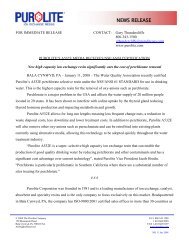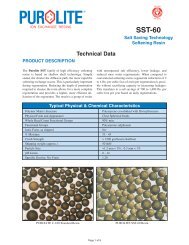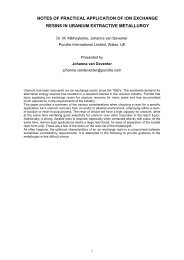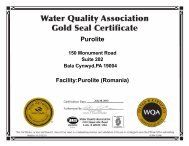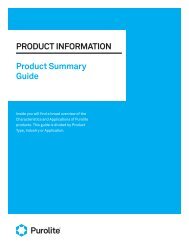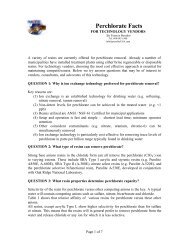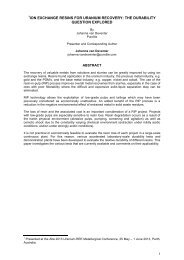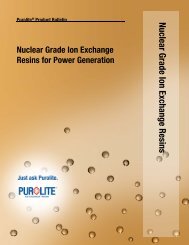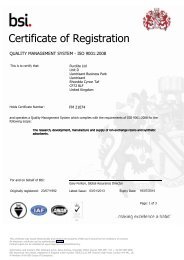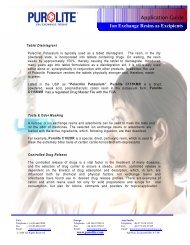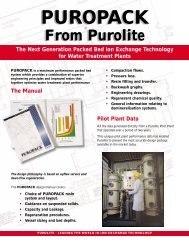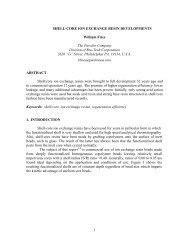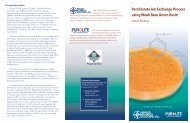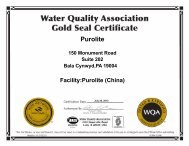Purolite Water Softening Resin Guide By: Chubb Michaud Water ...
Purolite Water Softening Resin Guide By: Chubb Michaud Water ...
Purolite Water Softening Resin Guide By: Chubb Michaud Water ...
Create successful ePaper yourself
Turn your PDF publications into a flip-book with our unique Google optimized e-Paper software.
Application Notes<strong>Water</strong> <strong>Softening</strong> Basics<strong>Purolite</strong> ® <strong>Water</strong> <strong>Softening</strong> <strong>Resin</strong> <strong>Guide</strong><strong>By</strong>: <strong>Chubb</strong> <strong>Michaud</strong><strong>Water</strong>, passing through the atmosphere as snow or rain, picks up carbon dioxide (CO2) and otheracid gases and reaches the Earth’s surface as a weakly acidic solution (CO 2 + H 2 O H 2 CO 3 )commonly referred to as carbonic acid.. The rain that falls into surface waters such as streams,rivers, ponds and lakes are normally low in dissolved solids and hardness.As this water soaks in, it passes through various strata containing limestone (CaCO 3 ) whichneutralizes the acid forming a soluble calcium bicarbonate salt (H 2 CO 3 + CaCO 3 Ca (HCO 3 ) 2which then dissociates into ions. (Ca ++ ) ions with a plus 2 positive charge is a cation and HCO 3-with a single negative charge contributes two anions. This is how calcium (and magnesium) endup in all our water supplies. Where the calcium and magnesium content is high these waters aredescribed as “hard” waters.When hard water is heated, the Ca(HCO 3 ) 2 decomposes to CaCO 3 and evolves CO 2 gas and H 2 O(water). CaCO 3 is insoluble and deposits on the surfaces of water heaters, often found in boilers,coffee makers, pipes and on to fabrics, creating a hard scale (known as calcite, lime scale, boilerscale or hardness scale). This scale is a poor conductor of heat and so it takes more energy toheat water if the heater element or boiler tube is covered with this scale. Scale can also clogpipes and appliances and reduces the life of fabrics due to its abrasive nature. In addition, whenwashing you will notice the soluble calcium and magnesium salts will react with soap causingthe familiar bathtub ring and soap scum. Needless to say, it is often desirable to removehardness ions before using the water in residential as well as industrial applications.Ion exchange is often the process of choice for removing hardness ions. In domestic applicationsa low level of hardness can be permitted. In industrial applications, particularly boilers, totalhardness has to be almost totally removed.Ion exchange was first observed and recognized by Thompson and Way in 1858 noting thatwhen an ammonium salt was poured through soil, a different water composition trickled out ofthe bottom of the container. The soil had captured the ammonium ion and released sodium.Natural soil contains clays and zeolites that have ion exchange capabilities. <strong>By</strong> order ofselectivity, multi-valent ions are grabbed onto by ion exchangers which will then release a lesstightly held ion (which is often more desirable). It should be noted that mono-valent ions such assodium or potassium do not cause scale and do not react with soap.USA Europe Asia PacificTelephone: (1) 610-668-9090 Telephone: +44 1443 229334 Telephone: +86 571 876 31385Fax: (1) 610-668-8139 Fax: +44 1443 227073 Fax: +86 571 876 31385Email: info@puroliteusa.com Email: sales@purolite.com Email: pultalan@purolitechina.com© 2007 All Rights Reserved www.purolite.com App Notes_<strong>Water</strong>Soft_9-20-07
Zeolites were synthesized in 1903 offering higher capacity and stability than the natural zeolitesand German industrial pioneer, Robert Gans commercialized the first regenerable ion exchangerfor removing hardness in 1905.The synthesis of new chemistry gradually improved the efficiency of the regenerable softenerthrough the 1940s when G.F. D’Alelio of GE produced the first suspension polymers of styreneand di-vinyl benzene (S/DVB) which gave birth to the modern ion exchanger.The basic chemistry of softening resins has remained unchanged since that time. Ion exchangesoftening systems use reactive plastic polymer beads with chemical functionality that selectivelycaptures the di-valent ions such as calcium and magnesium and releases less tightly held monovalentions, normally sodium. The reaction is as follows:<strong>Softening</strong> ReactionsServiceCa(HCO 3 ) 2 + + 2 NaHCO 3RegenerationCa ++ + NaClNa +Na +Ca ++Hardness <strong>Resin</strong> Exhausted Soft <strong>Water</strong>Na ++ CaCl 2 + NaClNa +Exhausted Salt <strong>Resin</strong> Waste Excess SaltThe means that there is equilibrium between the water composition and the amount ofhardness that can be removed. It also means that the reaction is reversible should there be a highdriving force applied to the exhausted resin. If that driving force is a concentrated brine (NaCl orKCl), the hardness on the expended resin is driven off and the mono-valent sodium or potassiumtakes its place.This is called “regeneration”. So a softener system, consisting of resin beads in a bed that hasthe ability to pick up hardness by ion exchange (hardness exchanged for “softness” ) and then beregenerated by a high concentration (10% brine) of salt and have its capacity restored. Thesystem can be used over and over and lasts for years.USA Europe Asia PacificTelephone: (1) 610-668-9090 Telephone: +44 1443 229334 Telephone: +86 571 876 31385Fax: (1) 610-668-8139 Fax: +44 1443 227073 Fax: +86 571 876 31385Email: info@puroliteusa.com Email: sales@purolite.com Email: pultalan@purolitechina.com© 2007 All Rights Reserved www.purolite.com App Notes_<strong>Water</strong>Soft_9-20-07
<strong>Water</strong> hardness is usually commonly reported in ppm (parts per million) or mg/l (milligrams perlitre as CaCO 3 (calcium carbonate) and fortunately 1 ppm = 1 mg/l.The term CaCO 3 defines a convention representing the number of ions to be exchanged. Thewater analysis is usually presented in mg/l (as the ion) which has to be converted to mg/l asCaCO 3 using conversion factors.The factor for Ca ++ is 2.5. You then multiply the mg/l as Ca ++ by 2.5 to get mg/l as CaCO 3 . ForMg ++ , the factor is 4.1.Once you have the calcium and magnesium as CaCO 3 calculated you add them to get totalhardness (as CaCO 3 ). The capacity of the resin, which will vary depending upon the salt doseper cubic foot of resin and can be approximated from the following table:Regen Level g/l (NaCl) Regen Level lbs (NaCl) Capacity (g/l) Capacity (Kgs/cf 3 )65 4 42 1896 6 48 21128 8 55 24160 10 60 27190 12 66 29240 15 70 30Once you have the capacity in g/l or ft 3 , multiply that number by the number of liters or cubicfeet of resin in the system to get system capacity. Then divide that number in by the amount ofhardness in the water supply in mg/l as CaCO 3 and this will indicate the amount of water that canapproximately be treated between regenerations in m 3 (x 1000 to get volume of water in litres).The basic softener consists of an exchange resin in a tank with a control valve (to control theregeneration cycles) and a brine source. Typically, it would look like this:USA Europe Asia PacificTelephone: (1) 610-668-9090 Telephone: +44 1443 229334 Telephone: +86 571 876 31385Fax: (1) 610-668-8139 Fax: +44 1443 227073 Fax: +86 571 876 31385Email: info@puroliteusa.com Email: sales@purolite.com Email: pultalan@purolitechina.com© 2007 All Rights Reserved www.purolite.com App Notes_<strong>Water</strong>Soft_9-20-07
The “Softener”in/outSdrain1. control valve2. resin tank3. media (resin)4. riser5. under-bedding6. brine tankThere are many factors controlling how well your softener works. One is the water composition.The higher the Ca and Mg of the raw water, the fewer gallons your system will produce betweenregenerations (cleanings). The more salt you use per regeneration, the better the performance (interms of percentage of hardness removed) and capacity (how much it will treat). Typically, a 15liter (1 cubic foot) unit regenerating with 160 g/l (8 lbs) of salt will produce 4500 liters (2100gallons) of treated water with a feed of 200 mg/l (10 gpm) hardnessRegeneration is generally initiated by a time clock, gallons meter or an electronic sensor. Duringregeneration, the service water may bypass the treatment system giving a hard water effluent. Toavoid this, industrial systems are designed with a twin alternating operation mode using twosystems.The first step in regeneration is to backwash the system by running water backwards through thebottom of the bed. This lifts the bed and dislodges dirt and debris. The bed is then settled andregenerated with a 10% salt solution. This step drives off the hardness and restores capacity.The bed is then rinsed and returned to service. The total time to regenerate is
Service Backwash Brine & Rinse Rinse/Refill/ServiceS S SSFor a typical home use, a 15 liter (1 ft 3 ) softener will serve most needs of a small home. If thewater is very high in total harness, (> 250 mg/l) (>25 gpm) or the family is large then a largersystems may be needed. Commercial and industrial systems are usually sized to produce acertain run length—say 8 hours. With a feed harness of 200 mg/l (12 gpm) and a flow of 10m 3 /h (25 gpm), the challenge is (200 x 10 / 1000 = 2 Kg load per hour) (12 x 25 x 60 min/hr =18,000 grains per hour) and if the run length needed is 8 hours (2 x 8 = 16 Kg)(18,000 x 8 =144,000) you divide the load (16 Kg) (144Kgr) by the capacity (say 50 g/l)(22 Krg) and we seethat we would need 0.32 m 3 (320 liters) (6.55 ft 3 ) resin volume in the softener.At 10 m 3 /h (25 gpm) , the relative flow rate would be (10/0.32 = 31.25 BV/h) (25/6.55 = 3.8gpm/ft 3 ) This flow is generally considered acceptable for residential and commercial needs butcritical applications (high pressure boilers) might choose to have a larger system with 650 litres(1 – 3 gpm/ft 3 ) on a operating 12 – 24 hour cycle. Residential systems often operateintermittently at flow rates of up to 80 BV/h (bed volume per hour) (10 gpm/ft3) of resin.Typical flows are much lower (average is closer to 20-30 BV/h) (2.5 gpm). As a result of higherflow peaks and the need to minimize brine usage lower regeneration levels are now beingemployed (120 g/l or less) (8 lbs/ft 3 ), residential systems generally experience higher levels ofhardness in the effluent but still less than 20 mg/l (1 gpg (17ppm)).When a resin system regenerates, only about 60% of the total capacity is restored. Somehardness is left on the resin. When next in service, some of this residual harness leaches off theresin creating a slight amount of hardness in the effluent. This is called “leakage”. The level ofleakage is determined in part, by the total amount of salt used to regenerate. Systems requiringvery low leakages (
notes determine this. Once the salt dose (for the quality needed) is determined, the capacity isset and the system design can be initiated.Capacity ResponseCAPACITY (kilograins/cu ft)302010theoretical = 6000 grains/lb salttypical = 3350 grains/lb saltreduced brine dose = ~4000 grains/lb saltand saves 87 lbs of salt per year00 1 2 3 4 5 6 7 8 9 10 11 12 13 14 15REGENERANT LEVEL (lb/cu ft)Although synthetic resins are very durable, they are subject to degradation due to oxidation andover time. Chlorine and any other oxidants are detrimental. Levels of 0.5 mg/l (0.5 ppm) havelittle affect on resin life but at higher levels the life of the resin can reduce dramatically. Also thepresence of metal ions such as iron (which is common) or copper in the feed water will foul theresin and promote oxidative breakdown and shorten the life further.The basics of ion exchangers have been chemically unchanged for more than 60 years.However, much has been done to improve the efficiency by modifying the bead structure.Normal beads range in particle size from 0.3 to 1.2 mm. This is called “standard Gaussiandistribution. This mix gives good capacity and minimal pressure loss. Most of what has beenwritten about softening pertains to this particle size distribution. The efficiency of softeningresins has been improved by newer manufacturing techniques which are capable of producingbeads that are more uniform in size. Uniform bead products such as <strong>Purolite</strong> PFC100E andPPC100 and PFC100 produce systems with lower pressure drops and better brine efficiencies (upto 10 to 15% over the standard beads). Finer mesh (0.2 to 0.4 mm) beads have also beenintroduced by <strong>Purolite</strong>. These small narrow grade resins are kinetically faster. Using fine meshresin such as <strong>Purolite</strong> C100EFM allows systems that are smaller in size with higher capacity andbetter brine efficiency (a gain of about 10% can be realized).The latest development is the SST bead (Shallow Shell Technology beads manufacturedexclusively by <strong>Purolite</strong> primarily for the USA market) which are not fully functionalized bydepth. This gives the performance of both fine mesh and uniform particle size resins whileproducing higher capacity and lower leakages than any other bead forms at any given salt level.USA Europe Asia PacificTelephone: (1) 610-668-9090 Telephone: +44 1443 229334 Telephone: +86 571 876 31385Fax: (1) 610-668-8139 Fax: +44 1443 227073 Fax: +86 571 876 31385Email: info@puroliteusa.com Email: sales@purolite.com Email: pultalan@purolitechina.com© 2007 All Rights Reserved www.purolite.com App Notes_<strong>Water</strong>Soft_9-20-07
目 次Ⅰ 平 成 24 年 度 決 算 の 概 要1 決 算 とは ・・・・・・・・・・・・・・・・・・・・・・・・・・・・・・・・・・・・・・・・・・・・・・・・・ 12 会 計 の 分 類 ・・・・・・・・・・・・・・・・・・・・・・・・・・・・・・・・・・・・・・・・・・・・・・・・・・・・ 13 決 算 収 支 の 状 況 ・・・・・・・・・・・・・・・・・・・・・・・・・・・・・・・・・・・・・・・・・・・・・・・・ 2Ⅱ 歳 入 の 状 況1 歳 入 の 構 造 ・・・・・・・・・・・・・・・・・・・・・・・・・・・・・・・・・・・・・・・・・・・・・・・・・・・・ 42 市 税 ・・・・・・・・・・・・・・・・・・・・・・・・・・・・・・・・・・・・・・・・・・・・・・・・・・・・・・・・・・ 63 地 方 交 付 税 ・・・・・・・・・・・・・・・・・・・・・・・・・・・・・・・・・・・・・・・・・・・・・・・・・・ 12(1) 「 三 位 一 体 の 改 革 」 ・・・・・・・・・・・・・・・・・・・・・・・・・・・・・・・・・・・・・・・・・ 13(2) 「 三 位 一 体 の 改 革 」による 東 村 山 市 の 影 響 額 ・・・・・・・・・・・・・・・・・・・・ 134 地 方 債 ・・・・・・・・・・・・・・・・・・・・・・・・・・・・・・・・・・・・・・・・・・・・・・・・・・・・・・ 14(1) 退 職 手 当 債 ・・・・・・・・・・・・・・・・・・・・・・・・・・・・・・・・・・・・・・・・・・・・・・ 15(2) 退 職 手 当 債 元 利 償 還 額 と 職 員 定 数 削 減 効 果 額 ・・・・・・・・・・・・・・・・・ 16Ⅲ 歳 出 の 状 況1 歳 出 の 分 類 ・・・・・・・・・・・・・・・・・・・・・・・・・・・・・・・・・・・・・・・・・・・・・・・・・・・ 182 目 的 別 経 費 ・・・・・・・・・・・・・・・・・・・・・・・・・・・・・・・・・・・・・・・・・・・・・・・・・・ 19(1) 目 的 別 経 費 の 一 般 財 源 負 担 額 ・・・・・・・・・・・・・・・・・・・・・・・・・・・・・・・ 21(2) 民 生 費 ・・・・・・・・・・・・・・・・・・・・・・・・・・・・・・・・・・・・・・・・・・・・・・・・・・ 22(3) 高 齢 化 率 ・・・・・・・・・・・・・・・・・・・・・・・・・・・・・・・・・・・・・・・・・・・・・・・・ 243 性 質 別 経 費 ・・・・・・・・・・・・・・・・・・・・・・・・・・・・・・・・・・・・・・・・・・・・・・・・・・ 25(1) 性 質 別 経 費 の 一 般 財 源 負 担 額 ・・・・・・・・・・・・・・・・・・・・・・・・・・・・・・・ 27(2) 義 務 的 経 費 ・・・・・・・・・・・・・・・・・・・・・・・・・・・・・・・・・・・・・・・・・・・・・・ 28(3) 人 件 費 ・・・・・・・・・・・・・・・・・・・・・・・・・・・・・・・・・・・・・・・・・・・・・・・・・・ 30(4) 扶 助 費 ・・・・・・・・・・・・・・・・・・・・・・・・・・・・・・・・・・・・・・・・・・・・・・・・・・ 33(5) 公 債 費 ・・・・・・・・・・・・・・・・・・・・・・・・・・・・・・・・・・・・・・・・・・・・・・・・・・ 35(6) 繰 出 金 ・・・・・・・・・・・・・・・・・・・・・・・・・・・・・・・・・・・・・・・・・・・・・・・・・・ 36(7) 投 資 的 経 費 ・・・・・・・・・・・・・・・・・・・・・・・・・・・・・・・・・・・・・・・・・・・・・・ 38Ⅳ 地 方 債 の 状 況1 地 方 債 残 高 ・・・・・・・・・・・・・・・・・・・・・・・・・・・・・・・・・・・・・・・・・・・・・・・・・・ 402 土 地 開 発 公 社 を 含 む 地 方 債 ( 借 入 金 ) 残 高 ・・・・・・・・・・・・・・・・・・・・・・・・・ 43Ⅴ 基 金 の 状 況1 基 金 残 高 ・・・・・・・・・・・・・・・・・・・・・・・・・・・・・・・・・・・・・・・・・・・・・・・・・・・・ 45



